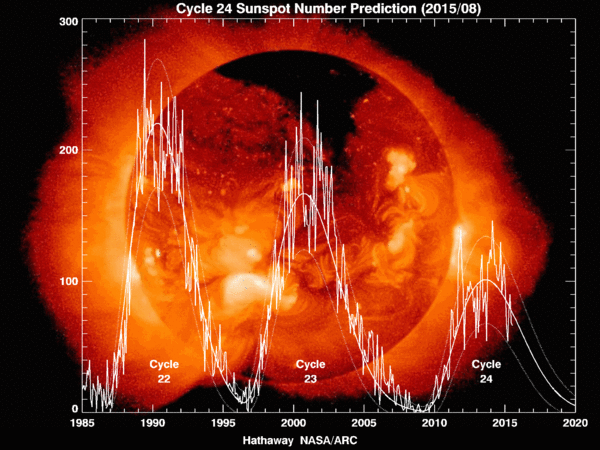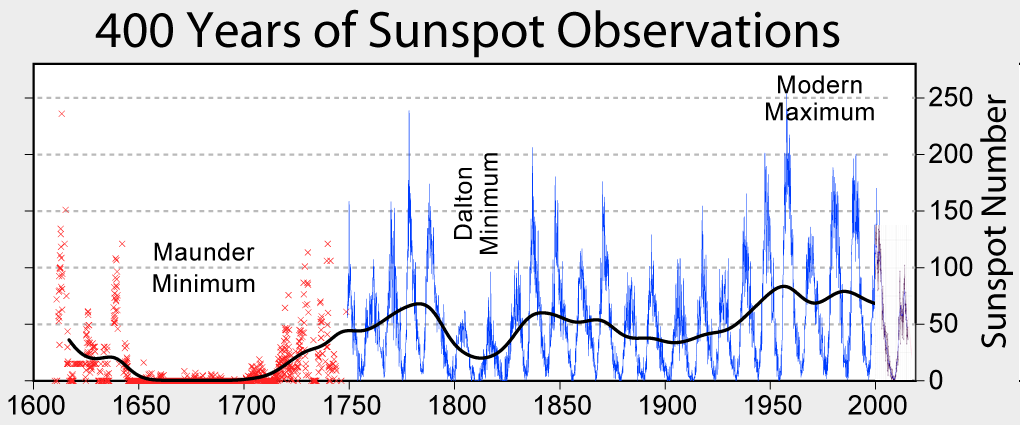Our sun has ‘lost its spots’, according to a headline in the science/technology section of the Sydney Morning Herald last week. Rather counter-intuitively, a decline in the number of dark spots on the sun is actually a sign of decreased activity. The gist of the piece is that the number of these spots (‘sunspots’) and their associated solar flares is falling. What implication does this have for rooftop solar PV?
As you may or may not be aware, the sun has an 11-year cycle during which its activity increases and decreases – and we are fast approaching this cycle’s ‘solar minimum’, which will occur around 2020. ‘Cycle 24’, as it is known, is expected to see even less solar activity than its predecessor, Cycle 23, which occurred in 2000-2001. This isn’t unusual – the intensity of solar maximums and minimums also varies over time, with some periods being characterised by higher or lower overall solar activity levels across multiple 11-year cycles.
Solar Cycles 22, 23 and 24 (predicted). (Image via
Although it might be tempting to conclude that this means less sunshine to fuel the world’s solar energy receptors (like the panels on the roofs of over 1.5 million Australian homes), the reality is that we’re not likely to notice any difference at all. According to a Skeptical Science article on the topic of the historic activity of the sun, even at the lowest known solar activity period (the Maunder Minimum, from roughly 1645-1715), the amount of solar energy reaching the Earth’s surface was only 0.25% less than modern day levels. A more recent but less intense solar minimum (the Dalton Minimum, from roughly 1790-1830), saw an overall solar irradiation level of only 0.08% less than today.
Historic observations of sunspot numbers. (Image via Wikipedia.)
What does that mean for your home’s (potential) solar energy production? Essentially nothing – the declines in solar fuel will be so minimal as to be unnoticeable except to the folks whose job (or hobby) it is to observe the behaviour of the sun. Remember that the sun is huge in comparison to our planet (the sun could contain 1,300,000 copies of the Earth, which is only about the size of the average sunspot), and any dramatic fluctuations in its activity would translate into massive (and possibly catastrophic) impacts for us. In short, if the sun’s activities were more volatile and chaotic, we probably wouldn’t be here in the first place.
Interestingly, it may be our own development as an ever more sophisticated tool-wielding species that brings us into conflict with the sun’s cycles, which until the modern era were mainly just an interesting topic of conversation. Of growing concern to us now is the issue of solar maximums – the periods when sunspots and solar flares occur more frequently. While these phenomena have not affected us much historically, as humanity relies increasingly on satellites for daily communications and transportation there is an increasing risk that they could impact us indirectly by knocking out our wireless technologies. In addition to inconveniencing the billions of people who use mobile phones and and the internet for work and daily life, it could also spell economic turmoil for the globe.
So the thing to keep in mind when you ponder the sun’s fluctuations is this: While sunspots and solar flares may at some point wreak havoc on your mobile reception, you can trust that the solar panels on your roof will continue to reliably pump out electricity so long as the sun remains visible in the sky.
© 2016 Solar Choice Pty Ltd
- Tesla Wall Charger (Gen 3): An Independent EV Charger Review by Solar Choice - 16 April, 2024
- Compare Solar Feed-in Tariffs – State by State - 12 April, 2024
- Which electricity retailer offers the best solar feed-in tariff? - 12 April, 2024

